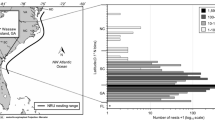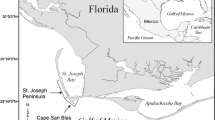Abstract
Few long-term mark-recapture tagging datasets exist to estimate population parameters for loggerhead sea turtle (Caretta caretta) recovery units. Using a two-state open robust design model, we analyzed a 20-year (1990–2009) mark-recapture dataset from the Keewaydin Island loggerhead nesting assemblage off the southwest coast of Florida (USA) in the eastern Gulf of Mexico. For this analysis, 2,292 turtle encounters were evaluated, representing 841 individual nesting turtles. Survival was estimated at 0.73 (95 % CI 0.69–0.76). This estimate is comparable with survival estimates elsewhere in the Peninsular Florida subpopulation and is among the lowest estimates for the Northwest Atlantic loggerhead population. We documented no changes in remigration rates or clutch frequency over time. These are the first survival and remigration probabilities estimated for a loggerhead nesting assemblage in the eastern Gulf of Mexico.





Similar content being viewed by others
References
Addison DS (1996a) Caretta caretta (loggerhead sea turtle) nesting frequency. Herpetol Rev 27:76
Addison DS (1996b) Mean annual nest frequency for renesting loggerhead turtles (Caretta caretta) on the southwest coast of Florida. Mar Turt Newsl 75:13–15
Balazs GH (1999) Factors to consider in the tagging of sea turtles. In: Eckert KL, Bjorndal KA, Abreu-Grobois FA, Donnelly M (eds) Research and management techniques for the conservation of sea turtles. IUCN/SSC Marine Turtle Specialist Group, pp 101–109
Bjorndal KA, Wetherall JA, Bolton AB, Morttimer JA (1999) Twenty-six years of green turtle nesting at Tortuguero, Costa Rica: an encouraging trend. Cons Biol 13(1):126–134
Bjorndal KA, Bolton AB, Chaloupka MY (2003) Survival probability estimates for immature green turtles Chelonia mydas in the Bahamas. Mar Ecol Prog Ser 252:273–281
Bjorndal KA, Bower BW, Chaloupka M, Crowder LB, Heppell SS, Jones CM, Lutcavage ME, Policansky D, Solow AR, Witherington BE (2011) Better science needed for restoration in the Gulf of Mexico. Science 331:537–538
Bowen BW, Abreu-Grobois FA, Balazs GH, Kamezaki N, Limpus CJ, Ferl RJ (1995) Trans-Pacific migrations of the loggerhead turtle (Caretta caretta) demonstrated with mitochondrial DNA markers. Proc Natl Acad Sci USA 92:3731–3734
Campagna C, Short FT, Polidoro BA, McManus R, Collette BB, Pilcher NJ, Sadovy de Mitcheson Y, Stuart SN, Carpenter KE (2011) Gulf of Mexico oil blowout increases risks to globally threatened species. Bioscience 61(5):393–397
Carr A, Caldwell DK (1956) The ecology and migrations of sea turtles, 1. Results of field work in Florida, 1955. Am Mus 1793:1–23
Davis GE, Whiting MC (1977) Loggerhead sea turtle nesting in Everglades National Park, Florida, USA. Herpetologica 33(1):18–28
Eckert KL, Beggs J (2006) Marine turtle tagging: a manual of recommended practices. WIDECAST technical report no. 2. Revised Edition. Beaufort, NC, p 40
Ehrhart LK, Redfoot WE, Bagley DA, Balfour (2007) Marine turtles of the central region of the Indian River Lagoon System, Florida. Fla Sci 70:415–434
“Endangered and Threatened Species; Determination of Nine Distinct Population Segments of Loggerhead Sea Turtles as Endangered or Threatened,” 76 Federal Register 58867 (22 September 2011), pp 58867–58952
Florida Fish and Wildlife Conservation Commission (2012) Trends in nesting by Florida loggerheads: a statistical analysis of trends in Florida’s loggerhead nest counts with data through 2012. http://myfwc.com/research/wildlife/sea-turtles/nesting/loggerhead-trends. Accessed 20 July 2013
Girard C, Tucker AD, Calmettes B (2009) Post-nesting migrations of loggerhead sea turtles in the Gulf of Mexico: dispersal in highly dynamic conditions. Mar Biol 156:1827–1839
Godley BJ, Broderick AC, Hays GC (2001) Nesting of green turtles (Chelonia mydas) at Ascension Island, South Atlantic. Biol Cons 97(2):151–158
Hart KM, Zawada DG, Fujisaki I, Lidz BH (2010) Inter-nesting habitat-use patterns of loggerhead sea turtles: enhancing satellite tracking with benthic mapping. Aquat Biol 11:77–90
Hart KM, Lamont MM, Fujisaki I, Tucker AD, Carthy RR (2012) Common coastal foraging areas for loggerheads in the Gulf of Mexico: opportunities for marine conservation. Biol Cons 145(1):185–194
Hart KM, Lamont MM, Sartain AR, Fujisaki I, Stephens BS (2013) Movements and habitat-use of loggerhead sea turtles in the Northern Gulf of Mexico during the reproductive period. PLoS One 8(7):e66921
Hatase H, Matsuzawa Y, Sato K, Bando T, Goto K (2004) Remigration and growth of loggerhead turtles (Caretta caretta) nesting on Senri Beach in Minabe, Japan: life-history polymorphism in a sea turtle population. Mar Biol 144:807–811
Kendall WL (2010) The ‘robust design’. In: Cooch E, White GC (eds) Program MARK: a gentle introduction, pp 15/1–15/50 http://www.phidot.org/software/mark/docs/book. Accessed 17 Aug 2010
Kendall WL, Bjorkland R (2001) Using open robust design models to estimate temporary emigration from capture-recapture data. Biometrics 57:1113–1122
Kendall WL, Nichols JD (2002) Estimating state-transition probabilities for unobservable states using capture-recapture/resighting data. Ecology 83:3276–3284
Lazar B, Margaritoulis D, Tvrtković N (2004) Tag recoveries of the loggerhead sea turtle Caretta caretta in the eastern Adriatic Sea: implications for conservation. J Mar Biol Assoc UK 84:475–480
Limpus CJ (1992) Estimation of tag loss in marine turtle research. Wildl Res 19:457–469
Lund F (1986) Nest production and nesting-site tenacity of the loggerhead turtle, Caretta caretta, on Jupiter Island, Florida. Master thesis, University of Florida
Marcovaldi MA, Chaloupka M (2007) Conservation status of the loggerhead sea turtle in Brazil: and encouraging outlook. Endang Spec Res 3:133–143
Miller JD (1997) Reproduction in sea turtles. In: Lutz PL, Musick JA (eds) The biology of sea turtles, vol 1. CRC Press, Boca Raton, FL, pp 51–81
Miller JD, Limpus CJ, Godfrey MH (2003) Nest site selection, oviposition, eggs, development, hatching, and emergence of loggerhead turtles. In: Bolten AB, Witherington BE (eds) Loggerhead sea turtles. Smithsonian Books, Washington, DC, pp 125–143
Murphy TM, Hopkins-Murphy SR (1990) Homing of translocated gravid loggerhead turtles. In: Richardson TH, Richardson JI, Donnelly M (eds) Proceedings 10th annual symposium on sea turtle biology and conservation. US Dept Commerce, NOAA Technical Memorandum NMFS-SEFSC-278, Miami, FL, pp 123–124
Musick JA, Limpus CJ (1997) Habitat utilization and migration in juvenile sea turtles. In: Lutz PL, Musick JA (eds) The biology of sea turtles. CRC Press, Boca Raton, FL, pp 137–163
National Marine Fisheries Service Southeast Fisheries Science Center (2008) Sea turtle research techniques manual. NOAA Technical Memorandum NMFS-SEFSC-579, p 92
National Marine Fisheries Service and U.S. Fish and Wildlife Service (2008) Recovery plan for the Northwest Atlantic population of the loggerhead sea turtle (Caretta caretta), Second Revision. National Marine Fisheries Service, Silver Spring, MD
Papi F, Liew HC, Luschi P, Chan EH (1995) Long-range migratory travel of a green turtle tracked by satellite: evidence for navigational ability in the open sea. Mar Biol 122:171–175
Papi F, Luschi P, Crosio E, Hughes GR (1997) Satellite tracking experiments on the navigational ability and migratory behaviour of the loggerhead turtle Caretta caretta. Mar Biol 129:215–220
Pfaller JB, Bjorndal KA, Chaloupka M, Williams KL, Frick MG, Bolten AB (2013) Accounting for imperfect detection is critical for inferring marine turtle nesting population trends. PLoS One 8(4):e62326
Phillips KF (2011) Beyond the beach: population trends and foraging site selection of a Florida loggerhead nesting assemblage. Master thesis, University of Miami
Pradel F (1996) Utilization of capture-mark-recapture for the study of recruitment and population growth rate. Biometrics 52:703–709
Rees AF, Salim AS, Broderick AC, Coyne MC, Papathanasopoulou N, Godley BJ (2010) Behavioural polymorphism in one of the world’s largest population of loggerhead sea turtles Caretta caretta. Mar Ecol Prog Ser 418:201–212
Richards PM, Epperly SP, Heppell SS, King RT, Sasso CR, Moncada F, Nodarse G, Shaver DJ, Medina Y, Zurita J (2011) Sea turtle population estimates incorporating uncertainty: a new approach applied to western North Atlantic loggerheads Caretta caretta. Endang Spec Res 15:151–158
Saba VS, Shillinger GL, Swithenbank AM, Block BA, Spotila JR, Musick JA, Paladino FV (2008) An oceanographic context for the foraging ecology of eastern Pacific leatherback turtles: consequences of ENSO. Deep Sea Res I 55:646–660
Sasso CR, Braun-McNeill J, Avens L, Epperly SP (2006) Effects of transients on estimating survival and population growth in juvenile loggerhead turtles. Mar Ecol Prog Ser 324:287–292
Sasso CR, Epperly SP, Johnson C (2011) Annual survival of loggerhead sea turtles (Caretta caretta) nesting in peninsular Florida: a cause for concern. Herpetol Cons Biol 6(3):443–448
Schaub M, Gimenez G, Schmidt BR, Pradel R (2004) Estimating survival and temporary emigration in the multistate capture-recapture framework. Ecology 85:2107–2113
Solow AR, Bjorndal KA, Bolton AB (2002) Annual variation in nesting numbers of marine turtles: the effect of sea surface temperature on re-migration intervals. Ecol Lett 5:742–746
Talbert OR, Stancyk SE, Dean JM, Will JM (1980) Nesting activity of the loggerhead turtle (Caretta caretta) in South Carolina I: a rookery in transition. Copeia 4:709–718
Troëng S, Chaloupka M (2007) Variation in adult annual survival probability and remigration intervals of sea turtles. Mar Biol 151:1721–1730
Tucker AD (2010) Nest site fidelity and clutch frequency of loggerhead turtles are better elucidated by satellite telemetry than by nocturnal tagging efforts: implications for stock estimation. J Exp Mar Biol Ecol 383(1):48–55
Turtle Expert Working Group (2009) An assessment of the loggerhead turtle population in the western North Atlantic. US Dept Commerce, NOAA Technical Memorandum NMFS-SEFSC-575, Miami, FL
White GC, Burnham KP (1999) Program MARK: survival estimation from populations of marked animals. Bird Stud 46(Suppl):120–138
Witherington B, Kubilis P, Brost B, Meylan A (2009) Decreasing annual nest counts in a globally important loggerhead sea turtle population. Ecol Appl 19(1):30–54
Acknowledgments
We especially thank the Conservancy of Southwest Florida, all the interns who have collected data on Keewaydin Island over the years, M. Kress and T. Tucker of Mote Marine Lab. Funding for this project was provided in part by the Cooperative Institute for Marine and Atmospheric Studies (CIMAS), a Cooperative Institute of the University of Miami and the National Oceanic and Atmospheric Administration, cooperative agreement #NA17RJ1226 and private donations from members and supporters of the Conservancy of Southwest Florida Sea Turtle Monitoring Project. Thanks also to D. Suman for his guidance and reviews.
Author information
Authors and Affiliations
Corresponding author
Additional information
Communicated by R. Lewison.
Rights and permissions
About this article
Cite this article
Phillips, K.F., Mansfield, K.L., Die, D.J. et al. Survival and remigration probabilities for loggerhead turtles (Caretta caretta) nesting in the eastern Gulf of Mexico. Mar Biol 161, 863–870 (2014). https://doi.org/10.1007/s00227-013-2386-2
Received:
Accepted:
Published:
Issue Date:
DOI: https://doi.org/10.1007/s00227-013-2386-2




